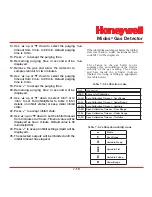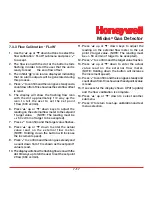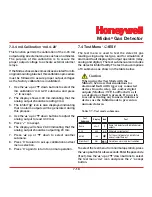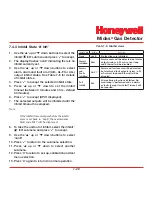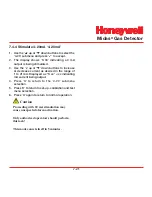
Midas
®
Gas Detector
7-18
7.3.4 mA Calibration ‘mA 4-20’
This function permits the calibration of the 4-20 mA
output using an external source such as an ammeter.
The purpose of this calibration is to assure the
proper output voltage to activate external alarms/
relays.
If the Midas chassis becomes disassociated from its
original mounting bracket, this calibration procedure
must be followed to assure proper output voltages
as the factory calibration is invalidated.
1. Use the ‘
s
’ up or ‘
t
’ down buttons to select the
mA calibration ‘mA 4-20’ submenu and press
‘
3
’ to accept.
2. The display shows 4.00 mA indicating that the
analog output should be reading 4 mA
3. The inhibit ‘ ’ icon is also displayed indicating
that no alarm outputs will be generated during
this process.
4. Use the ‘
s
’ up or ‘
t
’ down buttons to adjust the
analog output to read 4.00 mA.
5. Press ‘
3
’ to accept.
6. The display will show 20.00 indicating that the
analog output should be outputting 20 mA.
7. Press ‘
s
’ up or ‘
t
’ down to select another
submenu.
8. Press ‘X’ to return to set-up, calibration and test
menu selection.
9. Press ‘X’ again to return to normal operation.
7.4 Test Menu ‘
tESt’
The test menu is used to test the detector gas
reading using bump test gas, and for simulation of
alarm and fault display and output operation (relay,
analog and digital). The test submenu also includes
the detector inhibit facility. The test menu comprises
of 3 submenus as shown in the table below.
Caution
When using the Test Mode with the
Midas®, be aware that simulations for
alarm and fault will trigger any connected
devices from the relay, mA, and/or digital
outputs (Modbus /TCP, LonWorks®) as if
a real alarm or fault is present. If you wish
to avoid activating any connected alarms or
devices use the Inhibit mode to prevent an
unwanted alarm.
Table 7-7. Test mode submenus.
Test
Submenu
Display
Icon
Test
Bump
bUmP
Bump test detector with inhibited alarm
outputs
4-20
4-20
mA
Stimulate current output
Inhibit
Inh
Put the unit into/out of an inhibit state
and set inhibit time out
Alarm/Fault
SIm
Simulate an alarm and fault condition
To select the test menu from normal operation, press
the ‘
s
’ up button for a few seconds. Enter the pass code
(if set). Use the ‘
s
’ up or ‘
t
’ down buttons to select
the test menu ‘
’ icon and press the ‘
3
’ accept
button.
Summary of Contents for Midas
Page 7: ...Midas Gas Detector 1 1 1 Description ...
Page 9: ...Midas Gas Detector 2 1 2 Overview ...
Page 14: ...Midas Gas Detector 3 1 3 Default Configuration ...
Page 17: ...Midas Gas Detector 4 1 4 Installation ...
Page 41: ...Midas Gas Detector 5 1 5 Startup ...
Page 43: ...Midas Gas Detector 6 1 6 Operation ...
Page 53: ...Midas Gas Detector 7 1 7 Navigating Modes and Submenus ...
Page 74: ...Midas Gas Detector 8 1 8 Maintenance ...
Page 82: ...Midas Gas Detector 9 1 9 Pyrolyzer Module Options ...
Page 89: ...Midas Gas Detector 10 1 10 Optional LonWorks Interface Installation ...
Page 99: ...Midas Gas Detector 11 1 11 Troubleshooting and Fault Diagnosis ...
Page 102: ...Midas Gas Detector 12 1 12 REFLEX ...
Page 104: ...Midas Gas Detector 13 1 13 Internal Web Server ...
Page 106: ...Midas Gas Detector 13 3 Diagram 13 1 IPAddress setting in Windows XP ...
Page 129: ...Midas Gas Detector 14 1 14 Typical Installation Topologies ...
Page 132: ...Midas Gas Detector 15 1 15 Ordering Information ...
Page 136: ...Midas Gas Detector 16 1 16 Specifications ...
Page 139: ...Midas Gas Detector 17 1 17 Calibration and Bump Testing ...
Page 143: ...Midas Gas Detector A 1 A Modbus TCP Interface ...
Page 150: ...Midas Gas Detector B 1 B Gas Tables ...
Page 158: ...Midas Gas Detector C 1 C Warranty ...













